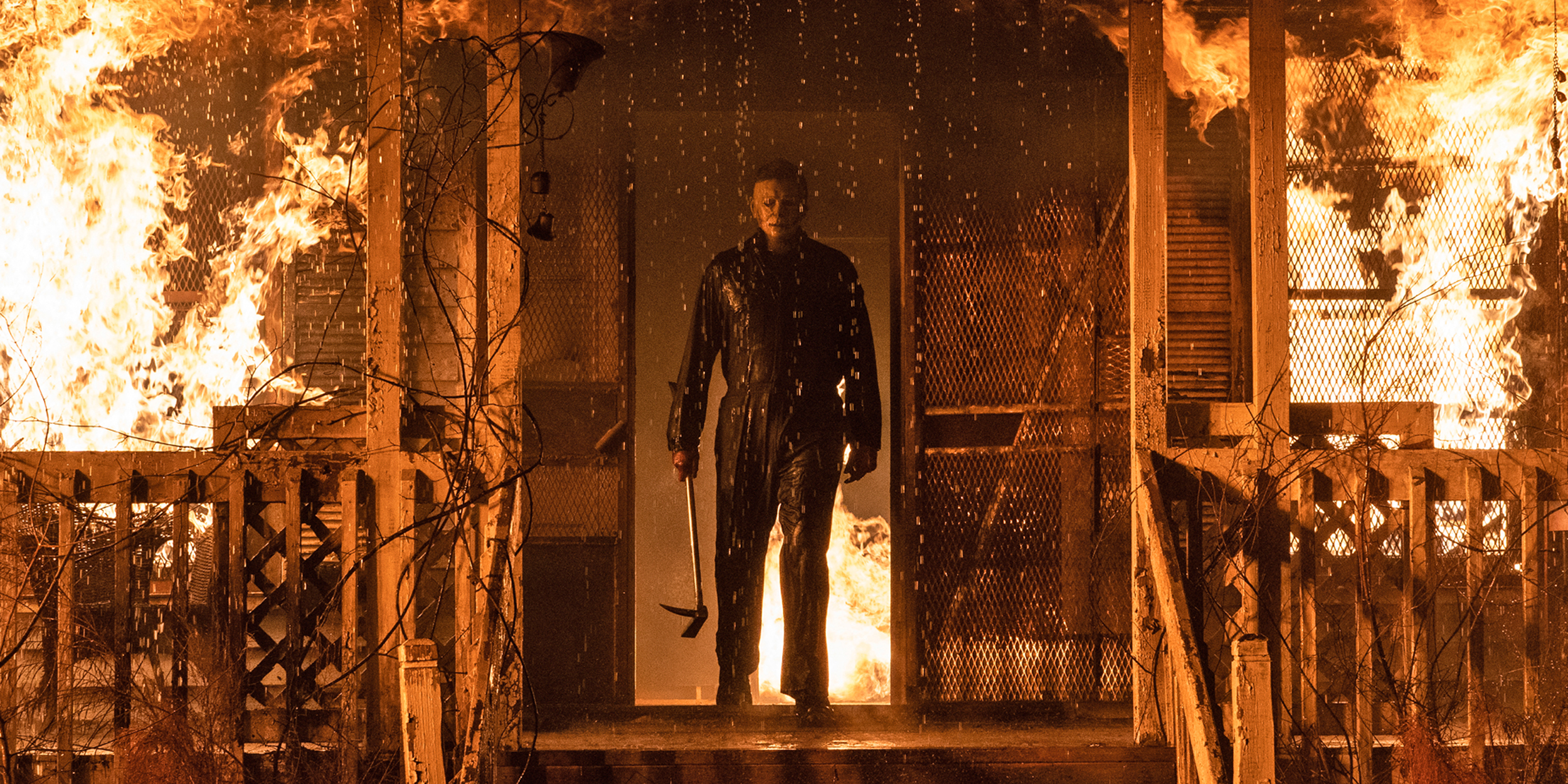
Michael Myers and Halloween have remained a staple of the season for over 40 years. He has haunted audiences, just as he has haunted Laurie Strode and Haddonfield, Illinois. You always know what to expect going into these films. Michael Myers survives his latest near-death encounter and is once again met with screams and leaves a trail of bodies in his wake. The sense of uneasiness is always immediately established thanks to John Carpenter’s famous theme, and after what many critics agree was an improvement on the Halloween sequels, David Gordon Green’s Halloween Kills begins seconds after the 2018 film, playing on the cheesiness of the early slashers to create nothing more than some good ol’ Halloween entertainment.
“Let it burn” is what Laurie (Jamie Lee Curtis) yells as firemen approach her home in ablaze. At the end of the previous installment, many were naive in believing that Michael Myers (Nick Castle and James Jude Courtney) had finally been defeated. Laurie is of that belief and her daughter Karen (Judy Greer) doesn’t have the heart to tell her that Michael Myers walked out alive. Brandishing a weapon in both hands, he lets us and every character know he’s not done yet. Then, the film takes time to expand on what happened seconds after Laurie escaped her first encounter with Michael on Halloween night in 1978; the attempted escape from the police, the violence that continued, and his eventual arrest. The fear and lore that surrounds the “Bogeyman” began that night and remains a part of Haddonfield’s identity. In Halloween Kills, the inhabitants of the fictional town come together to remember that night, remember the victims, and commend Laurie’s bravery. Setting this in a comedy club is a weird environment to begin in, especially for such a toast, but it provides the re-introduction to some survivors, including Lindsey (Kyle Richards), Marion (Nancy Stephens) and Tommy Doyle (Anthony Michael Hall). And once Michael arrives back home and begins his carnage once again, the town makes it clear that they’ve had enough of him and how his actions have infected their home. They’re shaken up, but they rally against him – Michael is no longer the only one on the hunt. Killing him seems, unsurprisingly, impossible as the body count begins to rise, and in all the chaos, Michael’s presence turns the town’s residents into monsters themselves.

Beginning the film in a comedy club is interesting because it gives the impression that this will be a lighter experience, or perhaps leaning into dark comedy territory. There are jokes here and there, with some unnecessary gimmicks that they tried almost too hard to be comedic, but there isn’t so much where it clashes with the film’s tone. In fact, it works to contrast the fun of Halloween versus the nightmare happening right outside. It does play up its ’70s slasher roots with familiar tropes and poor decision-making, but it doesn’t reach a level of annoyance. The weakest link, like many horror films, is definitely the dialogue, as it takes a back seat compared to everything else.
While 2018’s Halloween was Laurie’s film, Halloween Kills is undoubtedly Michael’s as Laurie isn’t in the film much, taking some needed rest while recovering in hospital. Probably the only peace she’s ever gotten in these past 40 years, but it’s brief as her stubbornness makes it difficult for Karen to keep her mother from doing something reckless. Curtis doesn’t get much to do this time around, but the same can’t be said for the other Strode women, including Laurie’s granddaughter Allyson (Andi Matichak). Greer as Karen has the task of playing a character who must try not to let her emotions get to her as she takes charge to try to protect her mother and tame the chaos that develops. Matichak gets some unfortunate scenes of bad dialogue, but she still manages to stand out as Allyson who takes matters into her own hands with an intense stare of determination and a shotgun in her hands. The film isn’t only about the trauma of the Strode women anymore, but of the town as a whole, while also touching on survivor’s guilt. This trauma and the return of Michael results in absolute mayhem, as all anyone wants is for it to end. There may be some awesome, bloody kills, with Michael using every weapon at his disposal, however, what’s really terrifying about this film is the mob mentality that forms. This results in a scene so unpleasant that every kill by Michael, no matter how brutal or intense, can’t even compare to the monstrous actions of your next-door neighbour.
The “filler episode” comparison is fair, as you do question why it was necessary for Halloween Kills to exist. With Halloween Ends coming up next year, it feels like Green and co. were trying to prolong Michael’s life for as long as possible before what we can assume will be his end. It could have been easy to have made 2018’s Halloween longer instead of the somewhat unsatisfying experience of having Laurie not be in the middle of the action. Despite its flaws, it’s still an enjoyable ride, especially if you love the slasher genre and the lore that Carpenter built. And while its themes are very much in-your-face, they work at reflecting society back at us; the angry world we live in, and constantly pointing fingers at someone else to excuse our hubris. Nothing good comes out of violence, Laurie explains, and it will be interesting to see how this nightmare is put to bed at long last.



